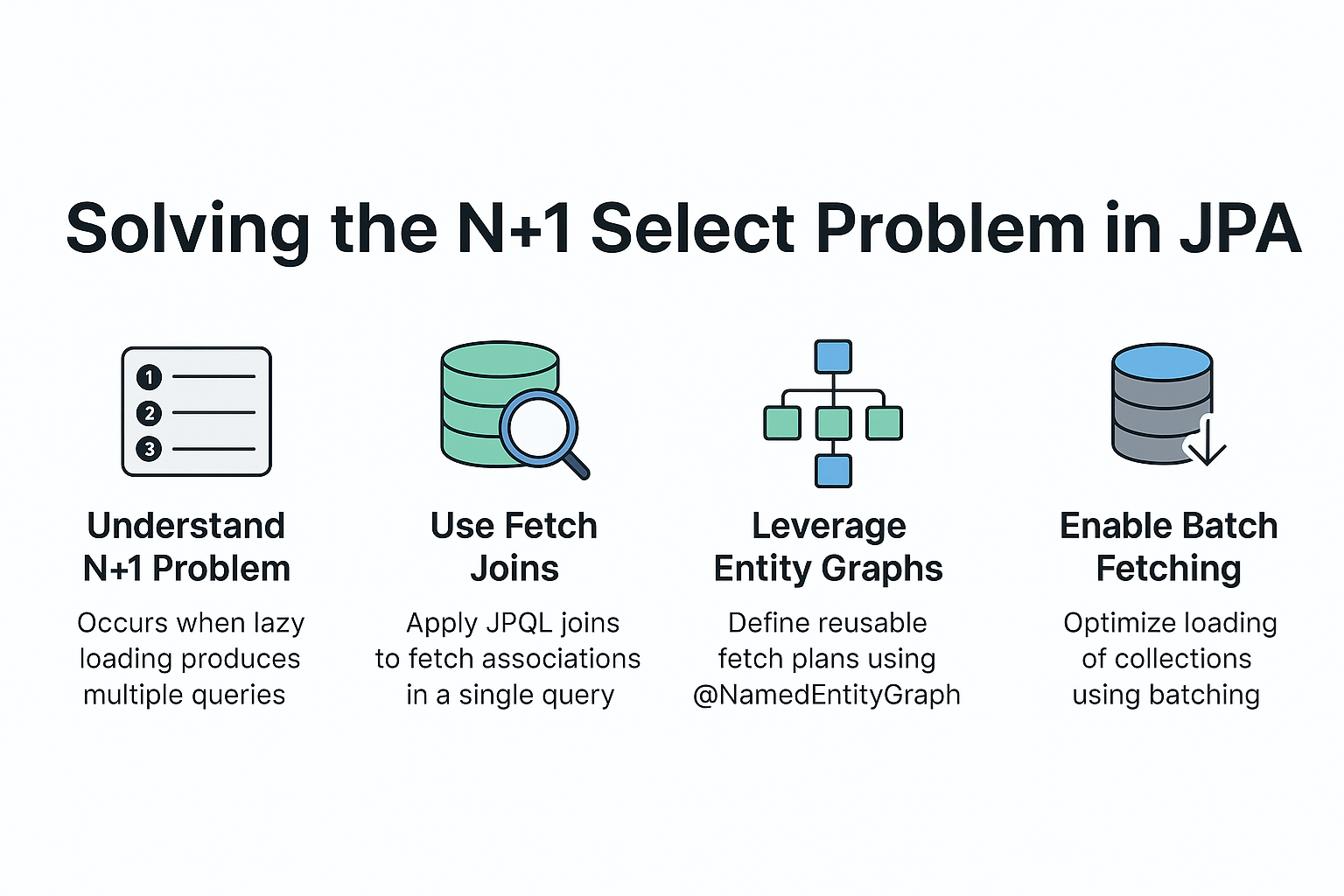The N+1 select problem is one of the most common performance issues developers face when using JPA and Hibernate. It occurs when fetching an entity along with its associated entities triggers multiple additional queries instead of a single optimized query.
- Example: Fetching 1 department and 10 employees may result in 11 queries instead of 1 join query.
- Left unresolved, this can cause severe performance degradation in production systems.
In this tutorial, we’ll cover what the N+1 problem is, why it happens, and how to fix it using fetch joins, entity graphs, and batch fetching strategies.
1. What is the N+1 Select Problem?
When JPA loads an entity with a collection or association using lazy loading, it executes:
- 1 query for the main entity.
- N additional queries for each associated entity.
Example SQL
-- Query 1: Fetch departments
SELECT * FROM departments;
-- Queries N: Fetch employees per department
SELECT * FROM employees WHERE department_id=1;
SELECT * FROM employees WHERE department_id=2;
...
If there are 100 departments, this results in 101 queries.
Analogy:
- N+1 = Asking each student individually for their grades instead of retrieving the whole class record at once.
2. Example Entities Setup
import jakarta.persistence.*;
import java.util.List;
@Entity
public class Department {
@Id
@GeneratedValue(strategy = GenerationType.IDENTITY)
private Long id;
private String name;
@OneToMany(mappedBy = "department", fetch = FetchType.LAZY)
private List<Employee> employees;
}
@Entity
public class Employee {
@Id
@GeneratedValue(strategy = GenerationType.IDENTITY)
private Long id;
private String name;
@ManyToOne
@JoinColumn(name = "department_id")
private Department department;
}
3. Reproducing the N+1 Problem
List<Department> departments = em.createQuery(
"SELECT d FROM Department d", Department.class).getResultList();
for (Department d : departments) {
for (Employee e : d.getEmployees()) {
System.out.println(e.getName());
}
}
SQL Output
SELECT * FROM departments;
SELECT * FROM employees WHERE department_id=1;
SELECT * FROM employees WHERE department_id=2;
...
4. Solutions to the N+1 Problem
4.1 Fetch Joins
List<Department> departments = em.createQuery(
"SELECT d FROM Department d JOIN FETCH d.employees", Department.class)
.getResultList();
SQL Output
SELECT d.*, e.*
FROM departments d
JOIN employees e ON d.id = e.department_id;
4.2 Entity Graphs
@Entity
@NamedEntityGraph(
name = "Department.withEmployees",
attributeNodes = @NamedAttributeNode("employees")
)
public class Department { ... }
EntityGraph<?> graph = em.getEntityGraph("Department.withEmployees");
List<Department> departments = em.createQuery(
"SELECT d FROM Department d", Department.class)
.setHint("jakarta.persistence.fetchgraph", graph)
.getResultList();
4.3 Batch Fetching
spring.jpa.properties.hibernate.default_batch_fetch_size=20
List<Department> departments = em.createQuery(
"SELECT d FROM Department d", Department.class).getResultList();
for (Department d : departments) {
d.getEmployees().size(); // Fetched in batches of 20
}
SQL Output
SELECT * FROM employees WHERE department_id IN (?, ?, ..., ?);
5. Integration with Spring Boot
Spring Data JPA allows fetch optimization with repository queries.
public interface DepartmentRepository extends JpaRepository<Department, Long> {
@Query("SELECT d FROM Department d JOIN FETCH d.employees WHERE d.id = :id")
Department findByIdWithEmployees(@Param("id") Long id);
}
Usage:
Department dept = repo.findByIdWithEmployees(1L);
dept.getEmployees().forEach(e -> System.out.println(e.getName()));
6. Performance Considerations
- Fetch Joins: Great for solving N+1, but avoid fetching too many associations at once.
- Entity Graphs: Flexible and reusable, better than hardcoding joins.
- Batch Fetching: Best when collections are large, avoids cartesian product issues.
7. Pitfalls and Anti-Patterns
- Overusing Fetch Joins: Can cause Cartesian product queries.
- Eager Fetching Everywhere: Increases unnecessary data loading.
- Mixing Multiple Solutions: Be consistent with strategy selection.
- Not Monitoring SQL Logs: N+1 issues often go unnoticed until production.
8. Best Practices
- Always monitor SQL logs for hidden N+1 queries.
- Use fetch joins for small, controlled relationships.
- Use entity graphs for reusable query definitions.
- Use batch fetching for large collections.
- Test with realistic data volumes.
📌 JPA Version Notes
- JPA 2.0: Introduced Criteria API, no entity graphs yet.
- JPA 2.1: Added entity graphs, making fetch control easier.
- Jakarta Persistence (EE 9/10/11): Migration from
javax.persistence→jakarta.persistence. No fetch-specific changes.
Conclusion and Key Takeaways
- The N+1 select problem occurs when lazy loading triggers multiple queries.
- Fetch Joins, Entity Graphs, and Batch Fetching are the main solutions.
- Choosing the right strategy depends on dataset size and query needs.
- Always profile SQL queries to ensure performance optimization.
FAQ (Expert-Level)
Q1: What’s the difference between JPA and Hibernate?
A: JPA is a specification, Hibernate is an implementation with extended features.
Q2: How does JPA handle the persistence context?
A: It caches managed entities and synchronizes them at transaction commit.
Q3: What are the drawbacks of eager fetching in JPA?
A: It loads unnecessary data, increasing memory and query execution time.
Q4: How can I solve the N+1 select problem with JPA?
A: Use fetch joins, entity graphs, or batch fetching strategies.
Q5: Can I use JPA without Hibernate?
A: Yes, providers like EclipseLink also support JPA.
Q6: What’s the best strategy for inheritance mapping in JPA?
A: Depends on use case — SINGLE_TABLE for performance, JOINED for normalization.
Q7: How does JPA handle composite keys?
A: Using @IdClass or @EmbeddedId annotations.
Q8: What changes with Jakarta Persistence?
A: Package renaming (javax.persistence → jakarta.persistence), with modern runtime improvements.
Q9: Is JPA suitable for microservices?
A: Yes, but lightweight alternatives may be better when fine SQL control is needed.
Q10: When should I avoid JPA?
A: Avoid JPA in high-performance analytics, batch ETL jobs, or real-time systems where raw SQL is more efficient.
